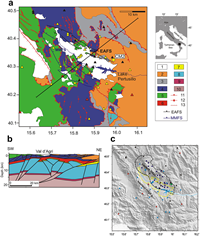Reservoir Structure and Wastewater-Induced Seismicity at the Val d’Agri Oilfield (Italy) Shown by Three-Dimensional Vp and Vp/Vs Local Earthquake Tomography
Improta L., S. Bagh, P. De Gori, L. Valoroso, M. Pastori, D. Piccinini, C. Chiarabba, M. Anselmi, M. Buttinelli (2017).
Journal of Geophysical Research: Solid Earth, 122/11, 9050-9082, doi: 10.1002/2017JB014725.
Abstract
Wastewater injection into a high-rate well in the Val d’Agri oilfield, the largest in onshore Europe, has induced swarm microseismicity since the initiation of disposal in 2006. To investigate the reservoir structure and to track seismicity, we performed a high-spatial resolution local earthquake tomography using 1,281 natural and induced earthquakes recorded by local networks. The properties of the carbonate reservoir (rock fracturing, pore fluid pressure) and inherited faults control the occurrence and spatiotemporal distribution of seismicity. A low-Vp, high-Vp/Vs region under the well represents a fluid saturated fault zone ruptured by induced seismicity. High-Vp, high-Vp/Vs bumps match reservoir culminations indicating saturated liquid-bearing zones, whereas a very low Vp, low Vp/Vs anomaly might represent a strongly fractured and depleted zone of the hydrocarbon reservoir characterized by significant fluid withdrawal. The comprehensive picture of the injection-linked seismicity obtained by integrating reservoir-scale tomography, high-precision earthquake locations, and geophysical and injection data suggests that the driving mechanism is the channeling of pore pressure perturbations through a high permeable fault damage zone within the reservoir. The damage zone surrounds a Pliocene reverse fault optimally oriented in the current extensional stress field. The ruptured damage zone measures 2 km along strike and 3 km along dip and is confined between low permeability ductile formations. Injection pressure is the primary parameter controlling seismicity rate. Our study underlines that local earthquake tomography also using wastewater-induced seismicity can give useful insights into the physical mechanism leading to these earthquakes.
http://agupubs.onlinelibrary.wiley.com/hub/issue/10.1002/jgrb.v122.11/


